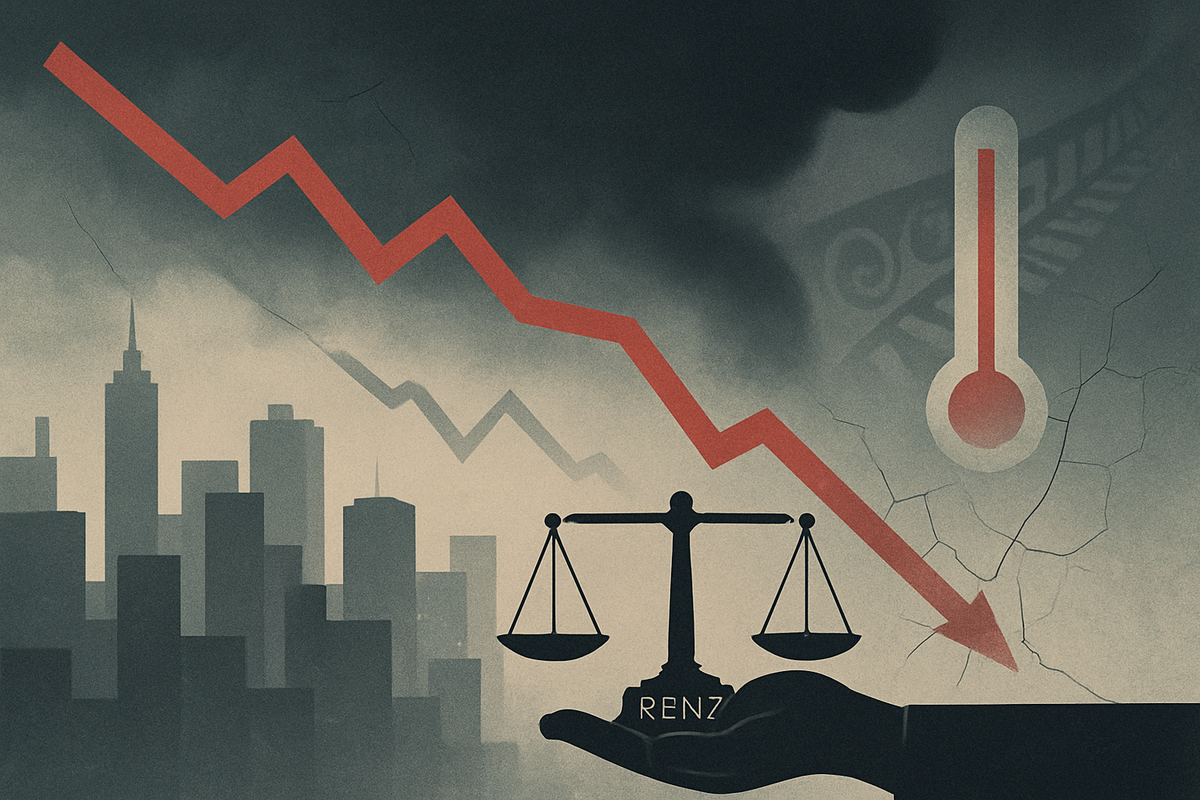
A concerning dip in New Zealand's business confidence during the third quarter of 2025 signals a persistent economic slowdown, even as underlying inflation pressures show signs of an unwelcome uptick. This confluence of factors paints a challenging picture for the island nation, reinforcing expectations that the Reserve Bank of New Zealand (RBNZ) will continue its accommodative monetary policy, likely through further interest rate cuts, to stimulate a struggling economy.
The latest economic data, particularly from a private think tank's survey, reveals a significant deterioration in business sentiment. Firms are scaling back investment and hiring plans, citing weak demand as their primary concern. This slump in confidence, coupled with rising price pressures, creates a complex environment for policymakers and businesses alike, pointing towards a period of continued sluggish growth and potential market volatility.
A Quarter of Caution: Detailed Insights into New Zealand's Economic Headwinds
New Zealand's Q3 2025 economic landscape was largely shaped by a notable weakening in business confidence, as highlighted by the NZIER Quarterly Survey of Business Opinion (QSBO). The survey revealed that a net 15% of firms anticipated improved economic conditions, a significant decrease from 26% in the previous quarter. Furthermore, actual business activity also saw a decline, with 14% of firms reporting weaker trading conditions. This softening of business sentiment brought confidence to its lowest level of the year, following a decade-high in the preceding months, suggesting that the economy remained sluggish, possibly flat or even slightly contracted in Q3. Businesses responded by reducing staff (net 23%) and cutting spending on plant and machinery (13%) and buildings (20%), indicating a contraction in employment and capital expenditure. Weak demand was overwhelmingly cited as the primary concern by 63% of firms, while labour shortages, a persistent issue in previous periods, have become less pressing.
Sectoral performance within the QSBO showed considerable disparity. The manufacturing sector emerged as the least optimistic, grappling with soft export demand and declining profitability. The construction sector also remained cautious due to weak new orders, reflecting a slowdown in building activity. In contrast, retailers showed the most optimism despite facing weak sales and high cost pressures, perhaps anticipating a rebound. Services firms also held out hope for future demand, potentially driven by falling interest rates. While the NZIER data painted a subdued picture, the ANZ Business Outlook Survey for September 2025 presented a slightly more resilient view, with its index remaining stable, reflecting sustained optimism about economic recovery, partly attributed to lower interest rates. Firms in the ANZ survey reported stronger expected activity and pricing intentions, though investment intentions softened slightly.
Despite the overarching theme of weakening business confidence and subdued economic activity, underlying inflation pressures showed a concerning tick upwards in Q3 2025. A net 11% of firms reported raising prices, reversing a trend of price cuts from the previous quarter. This short-term inflationary impulse occurred even as the Reserve Bank of New Zealand (RBNZ) had projected in its May 2025 statement that annual CPI inflation would reach 2.7% in Q3 2025, a forecast consistent with actual CPI inflation rising to 2.7% in Q2 2025. Interestingly, the RBNZ’s Q3 2025 survey of inflation expectations showed a slight easing in both two-year and one-year inflation expectations to 2.28% and 2.37% respectively, suggesting that while immediate cost pressures exist, longer-term inflation remains anchored within the RBNZ’s target band of 1-3%. The market's initial reaction to the Q3 data has been to solidify expectations for further RBNZ interest rate cuts, with some analysts forecasting two additional 25-basis-point cuts in October and November 2025, signaling a shift in the central bank's focus towards supporting growth.
Navigating the Headwinds: Potential Winners and Losers in the Current Climate
The current economic climate in New Zealand, characterized by softening business confidence and persistent inflation, will undoubtedly create a divide between companies that thrive and those that struggle. Businesses with strong balance sheets, efficient cost structures, and those in defensive sectors are likely to be more resilient, while those heavily reliant on consumer discretionary spending, investment, or export markets may face significant headwinds.
Companies involved in essential services or those with inelastic demand are poised to be relative winners. For instance, utilities, healthcare providers, and certain food and beverage companies may experience more stable demand even as the broader economy slows. Businesses that can effectively manage and pass on increased input costs without significantly impacting sales volumes will also fare better. Furthermore, companies that benefit from lower interest rates, such as those with significant debt or those in sectors like residential real estate (which might see a marginal boost from cheaper borrowing costs), could find some relief, though weak demand remains a significant counteracting force. Technology companies (NZX: TME) offering efficiency-enhancing solutions to other businesses might also see increased demand as firms seek to cut costs in a challenging environment.
Conversely, sectors heavily reliant on capital expenditure and consumer discretionary spending are likely to be among the losers. Construction companies, particularly those focused on new commercial or residential developments, will feel the pinch from reduced investment plans and weak new orders. Manufacturing firms (NZX: FBU, NZX: RUA), already battling soft export demand and declining profitability, will face continued pressure. Retailers (NZX: SVR) dealing in non-essential goods may see sales volumes decline as consumers tighten their belts amidst economic uncertainty and rising prices. Companies with high operating leverage or significant exposure to international trade, particularly exports to slowing global economies, will also face increased vulnerability. Furthermore, businesses that have been heavily reliant on easy credit or rapid expansion may find themselves in a precarious position as access to capital becomes more constrained and demand softens.
The banking sector, including major players like ANZ New Zealand (ANZ: ASX), Westpac New Zealand (WBC: ASX), and ASB (a subsidiary of CBA: ASX), will face a complex environment. While lower interest rates could ease pressure on borrowers, potentially reducing loan defaults, the overall slowdown in economic activity and reduced business investment could lead to slower loan growth. Their profitability will largely depend on their ability to manage net interest margins in a declining rate environment and their exposure to sectors most affected by the downturn.
Broader Implications: A "Stagflation-Lite" Scenario and Policy Responses
The current economic situation in New Zealand, characterized by weakening business confidence alongside persistent inflation, bears the hallmarks of a "stagflation-lite" scenario. This difficult combination presents a significant challenge for policymakers, as the economy struggles for growth while some price pressures stubbornly persist. It deviates from the ideal scenario of strong growth and contained inflation, placing the Reserve Bank of New Zealand (RBNZ) in a delicate balancing act. The RBNZ's primary mandate is price stability, but with growth faltering, the focus is increasingly shifting towards economic stimulus.
This event fits into a broader global trend where many developed economies are grappling with the lingering effects of supply chain disruptions, elevated energy prices, and robust wage growth, all contributing to inflationary pressures. Simultaneously, the post-pandemic boom is fading, and higher interest rates globally are starting to bite, leading to a deceleration in economic activity. New Zealand's situation is therefore not entirely isolated, reflecting a wider struggle to return to pre-pandemic economic stability. The uneven sectoral performance, with manufacturing and construction struggling while retail and services show some resilience, indicates a fragmented recovery, where different parts of the economy are responding to pressures in varied ways.
The most significant regulatory and policy implication is the reinforced expectation for further monetary easing by the RBNZ. The central bank is now widely anticipated to cut the Official Cash Rate (OCR) in the coming months, with forecasts suggesting two additional 25-basis-point cuts in October and November 2025. This dovish stance aims to inject liquidity into the economy, reduce borrowing costs, and encourage investment and consumption. However, the effectiveness of these cuts might be somewhat limited by the prevailing weak demand and business caution. Historically, such periods of low confidence and persistent inflation have often required sustained policy intervention, and the RBNZ will be carefully monitoring the impact of its actions on both inflation and employment.
Potential ripple effects on competitors and partners are also significant. New Zealand's trading partners, particularly Australia (ASX: ALLORDINARIES) and China (SSE: 000001), will be watching closely. A weaker New Zealand Dollar (NZD), a likely outcome of RBNZ rate cuts, could make New Zealand exports more competitive but imports more expensive. For companies with cross-border operations or supply chains, this could impact profitability and sourcing strategies. Domestically, businesses might delay expansion plans, reduce their reliance on external financing, and focus on operational efficiencies, potentially leading to a more competitive but also more cautious business environment.
The Path Ahead: Navigating Uncertainty and Seeking Opportunity
Looking ahead, New Zealand's economy faces a period of continued uncertainty, with both short-term challenges and long-term possibilities. In the immediate future, the market will be keenly focused on the Reserve Bank of New Zealand's (RBNZ) upcoming monetary policy statements. The strong likelihood of further interest rate cuts in October and November 2025 will be a critical factor influencing market sentiment and business decision-making. These cuts aim to provide a much-needed stimulus, but their effectiveness in quickly reversing the trend of weak demand and low business confidence remains to be seen. Businesses will need to adapt strategically, prioritizing cost control, enhancing productivity, and focusing on core competencies to navigate the subdued demand environment.
In the short term, companies may need to pivot towards more resilient business models, emphasizing customer retention and exploring niche markets less affected by the broader economic slowdown. For example, businesses that can offer value-for-money products or services might find opportunities as consumers become more price-sensitive. The easing of labor shortages, while indicative of a softer job market, could also present an opportunity for businesses to secure talent at more favorable terms, provided they have the demand to justify hiring. However, the persistent inflation pressures mean that managing input costs will remain a key challenge, requiring careful supply chain management and pricing strategies.
Longer term, if the RBNZ's rate cuts successfully stimulate demand and global economic conditions improve, New Zealand could see a gradual recovery in business confidence and investment. However, a prolonged period of "stagflation-lite" could lead to more entrenched economic challenges, potentially impacting long-term growth potential. Potential scenarios range from a relatively quick rebound driven by aggressive RBNZ action and a global upswing, to a more protracted period of slow growth if underlying structural issues or external headwinds persist. Market opportunities may emerge in defensive sectors, technology solutions that enhance efficiency, and companies with strong export ties that benefit from a weaker NZD, assuming global demand holds up.
Challenges will include navigating a potentially volatile New Zealand Dollar, managing persistent cost pressures, and adapting to a cautious consumer and business spending environment. Companies will need to maintain financial discipline, explore diversification, and invest in innovation to stay competitive. The government's fiscal policy will also play a crucial role, with any targeted spending or support measures potentially complementing the RBNZ's monetary easing efforts.
Wrap-Up: A Cautious Outlook and Key Indicators for Investors
New Zealand's Q3 2025 business confidence data delivers a sobering assessment of the nation's economic health, highlighting a concerning downturn in sentiment alongside stubbornly persistent inflation pressures. The key takeaway is an economy grappling with weak demand and reduced business activity, prompting businesses to pull back on investment and hiring. This "stagflation-lite" environment signals a period of continued sluggish growth, with the Reserve Bank of New Zealand (RBNZ) firmly positioned to implement further interest rate cuts in an effort to stimulate the economy.
Moving forward, the market is expected to remain cautious, with investors closely monitoring RBNZ announcements and subsequent economic data releases. While the anticipated rate cuts offer a glimmer of hope for a demand-led recovery, the immediate challenge lies in the dual pressures of low confidence and rising costs. Sectors sensitive to consumer spending and capital expenditure are likely to face ongoing headwinds, while defensive industries and businesses focused on efficiency and cost management may demonstrate greater resilience.
The significance of this period lies in its potential to reshape New Zealand's economic trajectory. A prolonged period of low confidence and moderate inflation could lead to a more entrenched low-growth environment, impacting long-term investment and employment. Conversely, successful monetary intervention, combined with a potential global economic upswing, could pave the way for a gradual recovery. Investors should prioritize companies with strong fundamentals, diversified revenue streams, and a proven ability to navigate challenging economic cycles.
In the coming months, investors should closely watch for several key indicators: the RBNZ's official cash rate decisions in October and November, subsequent business confidence surveys (both NZIER and ANZ), and, crucially, the Consumer Price Index (CPI) data to assess the trajectory of inflation. Any signs of sustained disinflation or a significant rebound in business activity would be pivotal in determining the market's direction and the overall health of the New Zealand economy.
This content is intended for informational purposes only and is not financial advice.





